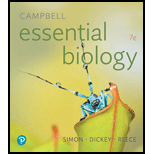
Concept explainers
a.
Introduction:
The group of organisms present within an ecosystem occupying the same level in the food chain is known as trophic level. The trophic structure of a community determines the flow of energy and matter as they move from photosynthetic organisms to herbivores and then to the predators.
b.
Introduction:
The group of organisms present within an ecosystem occupying the same level in the food chain is known as trophic level. The trophic structure of a community determines the flow of energy and matter as they move from photosynthetic organisms to herbivores and then to the predators.
c.
Introduction:
The group of organisms present within an ecosystem occupying the same level in the food chain is known as trophic level. The trophic structure of a community determines the flow of energy and matter as they move from photosynthetic organisms to herbivores and then to the predators.
d.
Introduction:
The group of organisms present within an ecosystem occupying the same level in the food chain is known as trophic level. The trophic structure of a community determines the flow of energy and matter as they move from photosynthetic organisms to herbivores and then to the predators.
e.
Introduction:
The group of organisms present within an ecosystem occupying the same level in the food chain is known as trophic level. The trophic structure of a community determines the flow of energy and matter as they move from photosynthetic organisms to herbivores and then to the predators.
Want to see the full answer?
Check out a sample textbook solution
Chapter 20 Solutions
Campbell Essential Biology (7th Edition)
- In the English Channel ecosystem, the number of primary producers is smaller than the number of primary consumers because________. a. the apex consumers have a low turnover rate b. the primary producers have a low turnover rate c. the primary producers have a high turnover rate d. the primary consumers have a high turnover ratearrow_forwardThe total amount of living tissue within a given trophic level is called the: O A. Biomass O B. Energy mass C. Organic mass O D. Trophic massarrow_forwardChoose the best answer. 1. The loss of energy at each trophic level is caused by the following EXCEPT: a. Food passing through animals are partially digested b. Energy is transformed from mechanical energy or other forms c. Energy is lost during anabolic processes 2. It is referred to as the physical and biotic habitat which surrounds us, that which we can see, touch, and smell. a. System b. Community c. Environment d. Ecology 3. A group of plant and animal population living in the same environment a. ecosystem b. species c. community d. population 4. The variation in environmental conditions that is beyond the range of tolerance may result in a. None of these b. Deterioration of ecosystem c. Both b and d d. Loss of species that are vital links in food webs 5. Transpiration is a process involved in a. carbon dioxide b. phosphorus c. nitrogen d.…arrow_forward
- The loss of an apex consumer would impact which trophic level of a food web? a. primary producers b. primary consumers c. secondary consumers d. all of the abovearrow_forwardThe producer in an ocean grazing food web is usually a _____. a. plant b. animal c. fungi d. planktonarrow_forwardOrganisms at the first trophic level ________. a. capture energy from a nonliving source b. are eaten by organisms at lower trophic levels c. are shown at the top of an energy pyramid d. are consumersarrow_forward
- Primary productivity on land is affected by _______. a. nutrient availability c. temperature b. amount of sunlight d. all of the abovearrow_forwardBased on the text for mosquitoes eating: 1. Identify abiotic factors that support the survival and reproduction of the mosquitoes. 2. Identify biotic factors that support the survival and reproduction of the mosquitoes. 3. Predict what factors in the environment can be altered to decrease the survival and reproduction of the mosquities. PLEASE ANSWER BASED ON THE TEXT ONLYarrow_forwardWhich of the following is a process of the nitrogen cycle that involves the conversion of nitrogen gas to ammonia? a.Nitrogen fixation b.Nitrification c.Ammonification d.Denitrificationarrow_forward
- Which trophic level is vital to the continuation of the carbon cycle? Group of answer choices a. tertiary consumer b. secondary consumer c. producer d. primary consumerarrow_forwardGross primary productivity refers to the total a. energy used by the heterotrophs of the ecosystem in a given period of time b. energy captured initially by the producers c. quantity of solar energy reaching a given area of the ecosystem d. quantity of solar energy available to the ecosystem in a given period of time e. energy used by the producers for their growth and reproductionarrow_forward1. Which processes remove nitrogen from the atmosphere? I. Fertilizer production II. Eutrophication III. Nitrogen fixation IV. Denitrification A. I and II B. I and III C. I and IV D. II and III Е. II and IV The net primary production (NPP) of a stable lake ecosystem is roughly equal to the amount of 2. A. phytoplankton present in the photic zone B. phytoplankton consumed by heterotrophs C. dissolved nutrients used by phytoplankton D. dissolved oxygen used by phytoplankton E. dissolved oxygen used by all consumersarrow_forward

 Biology: The Dynamic Science (MindTap Course List)BiologyISBN:9781305389892Author:Peter J. Russell, Paul E. Hertz, Beverly McMillanPublisher:Cengage Learning
Biology: The Dynamic Science (MindTap Course List)BiologyISBN:9781305389892Author:Peter J. Russell, Paul E. Hertz, Beverly McMillanPublisher:Cengage Learning Concepts of BiologyBiologyISBN:9781938168116Author:Samantha Fowler, Rebecca Roush, James WisePublisher:OpenStax College
Concepts of BiologyBiologyISBN:9781938168116Author:Samantha Fowler, Rebecca Roush, James WisePublisher:OpenStax College


